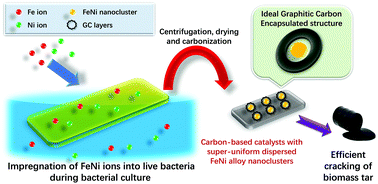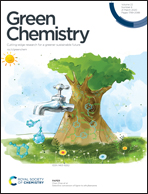Graphitic carbon embedded with Fe/Ni nano-catalysts derived from bacterial precursor for efficient toluene cracking†
Abstract
The environmentally-harmful by-product – biomass tar – is the major obstacle during biomass gasification, which produces synthetic gas as a clean energy source from agricultural waste or other bio-wastes. The highly-dispersed Fe/Ni-based nano-catalysts are of great research interest because of their great catalytic performance for catalytic biomass tar cracking. Supported Fe/Ni alloy catalysts were recognized as promising tar-cracking catalysts with the ability of redox enhancement and carbon deposition prevention. However, the controllable synthesis of highly-dispersed Fe/Ni nano-catalysts with high activity and stability remains a huge challenge. In this work, highly-dispersed FeNi alloy catalysts embedded in graphitic carbon (BC-FeNi) were successfully synthesized by simple calcination of a bacterial precursor, which can be easily harvested by collecting non-pathogenic bacteria in a Fe/Ni ion enriched liquid medium. The bacteria served as a carbon source and helped to uniformly distribute the iron–nickel ions in the precursor for subsequent preparation of highly-dispersed FeNi catalysts. Transmission electron microscopy showed the BC-FeNi contained well-dispersed iron-nickel nanoparticles with sizes of 3–10 nm in a mesoporous graphitic carbon matrix, which were beneficial for the protection of metal nanoparticles against coking and thus were highly desirable for catalytic biomass tar cracking. The conversion rate of the biomass tar model compound – toluene by BC-FeNi nano-catalysts was 82.6% at 700 °C and 95.8% at 800 °C, which were significantly superior over the control sample supported by active carbon. Noticeably, the metal loading (1.01 wt%) in the bacteria-derived BC-FeNi catalysts was very lower compared to previous studies using other synthetic methods (usually >10 wt%). This unique nature grants that the bacterial method may enable the facile design and synthesis of other types of practical nano-materials.



 Please wait while we load your content...
Please wait while we load your content...